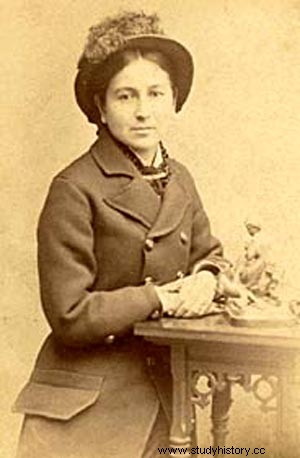Susette La Flesche, LaFlesche Tibbles Pacifier or Inshata Theumba is a writer, speaker, and artist of Native American descent, from the Omaha people, who has been an activist for Native American rights.
Cultural assimilation
 Born 1854 in Nebraska, Susette, or Inshata Theumba (bright eyes) is the daughter of Mary Gale, or Hinnuaganun (a woman) and Joseph LaFlesche, or Insta Maza (iron eye), the last chief of the Omahas. Mary is the daughter of Ni-co-ma, a Native American Iowa, and John Gale, a surgeon. Joseph is himself the son of a French immigrant and Waoowinchtcha, his wife, a Native American from the Ponca people. Adopted by the chief of the Omaha people, Joseph succeeds him and becomes their last traditional chief. Susette lost her mother very young, when she was about a year old. Subsequently, Joseph remarried an Omaha woman, with whom he would have other children.
Born 1854 in Nebraska, Susette, or Inshata Theumba (bright eyes) is the daughter of Mary Gale, or Hinnuaganun (a woman) and Joseph LaFlesche, or Insta Maza (iron eye), the last chief of the Omahas. Mary is the daughter of Ni-co-ma, a Native American Iowa, and John Gale, a surgeon. Joseph is himself the son of a French immigrant and Waoowinchtcha, his wife, a Native American from the Ponca people. Adopted by the chief of the Omaha people, Joseph succeeds him and becomes their last traditional chief. Susette lost her mother very young, when she was about a year old. Subsequently, Joseph remarried an Omaha woman, with whom he would have other children.
An influential family among the Omahas, the La Flesches advocate for their children, and for the future of their people, cultural assimilation. Thus, they support missionary schools and hire white teachers for their five children. Susette and her younger sisters, Marguerite and Susan, are sent to attend an all-girls school in New Jersey, where they receive an excellent education. Very quickly, Susette proves to be gifted for studies and in particular for writing. After her studies, Susette worked as a teacher on the Omaha reservation.
The Standing Bear Trial
When the Poncas are deported from their lands in Nebraska to the Great Sioux Reservation, given their own Ponca origins, Susette La Flesche and her father travel to Oklahoma to investigate the conditions of the move. There they discover a dire situation:the Poncas were deported too late in the year to plant crops, supplies promised by the government are late, and a malaria epidemic has broken out. Nearly a third of the tribe died the year after the deportation, including the son of Chief Standing Bear. When Standing Bear leaves the reservation, along with a few men, to bury his son in the land of his ancestors, they are arrested by the federal government. Susette then worked with journalist Thomas Tibbles to publish the conditions of the Poncas' deportation in the Omaha World Herald, and to denounce the arrest of Standing Bear. This coverage will allow Chief Ponca to obtain pro bono legal assistance from two lawyers during his trial, during which Susette serves as his interpreter. She also testifies to the living conditions on the Indian reservation. Standing Bear disputes the lack of cause for his arrest and imprisonment, arguing that Native Americans have the same rights as American citizens. He won his case, and the lawsuit garnered national attention, becoming iconic for Native American civil rights.
Following the trial, Susette and her half-brother Francis, who had become an ethnologist, accompanied Standing Bear on a lecture tour in the eastern United States. Susette translates Standing Bear's speeches and also gives her own lectures. With Thomas Tibbles, she testified in Washington, before a congressional committee, on the conditions of deportation of the Poncas, and she spoke out in favor of the rights of Native Americans. In 1881, she married Thomas, with whom she settled in Nebraska. She writes novels, short stories, essays, but also devotes herself to the culture of her land as a member of the Omaha reservation. In parallel, the couple continue to investigate and write about living conditions on Native American reservations.
In 1887, Susette and Thomas again accompanied Standing Bear on a lecture tour of England and Scotland. In 1890, they denounced the Wounded Knee Massacre, during which between 300 and 350 Native Americans of the Lakota Miniconjou tribe were massacred by the American army.
Susette La Flesche died on May 26, 1903, at the age of forty-nine.
